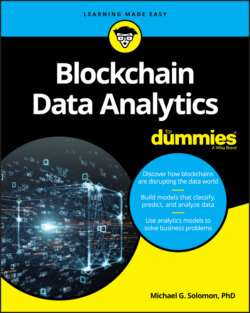Читать книгу Blockchain Data Analytics For Dummies - Michael G. Solomon - Страница 68
Identifying Blockchain Data with Value
ОглавлениеIN THIS CHAPTER
Describing blockchain data
Examining common data in blocks
Relating blockchain data to common application data
Mapping blockchain data to business processes
Many descriptions of blockchain technology relate it to well-known data storage techniques. One of the more popular descriptions states that a blockchain is essentially a distributed ledger of transactions. This description is somewhat true but overly simplified. A blockchain does store transactions like a ledger and is distributed, but it contains far more interesting information. If a blockchain only stored transactions it wouldn’t be very interesting because it would be little more than a distributed spreadsheet.
A blockchain is far more than just a distributed spreadsheet — it contains an indelible record of the data’s current state (current values) and a complete historical record of how the data came to the current state. Traditional data repositories generally store only the final state of data. As you make changes, those changes overwrite any previous values. More sophisticated data repositories maintain audit records, which are generally external notes that record changes to data values.
Additionally, blockchain apps can create logging entries that document events that occur as smart contracts execute. The ability to record activities can provide a view of how data changes, not just the fact that it did change. And finally, each block in a blockchain stores information about the functions — and input parameters — in a smart contract that an application calls.
In this chapter, you learn about the different types of data available to you in a blockchain environment and how you can identify data that might be useful for analysis.
